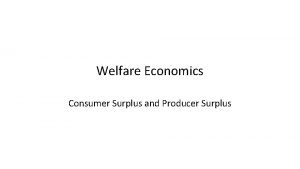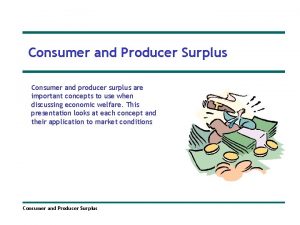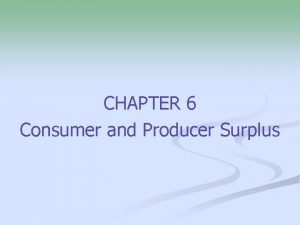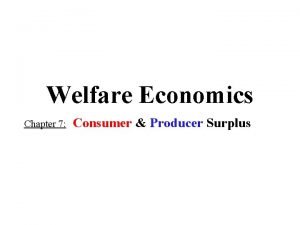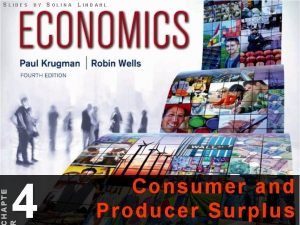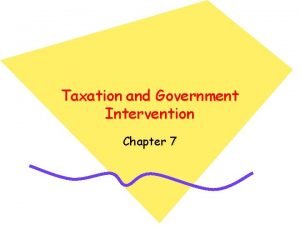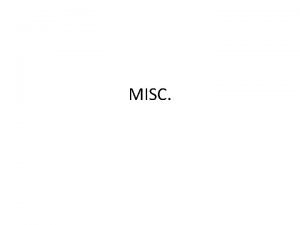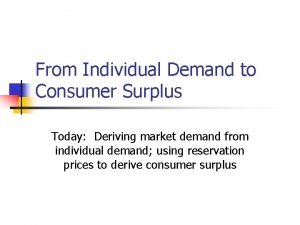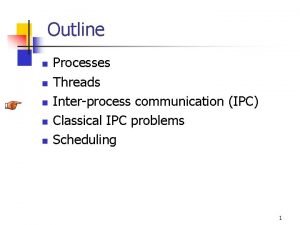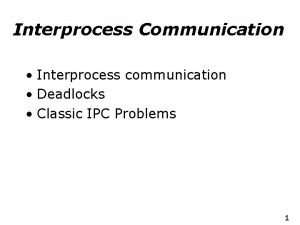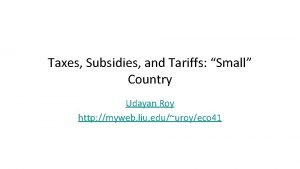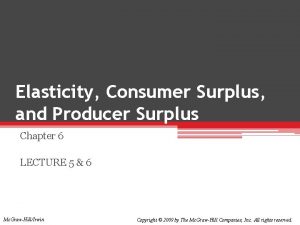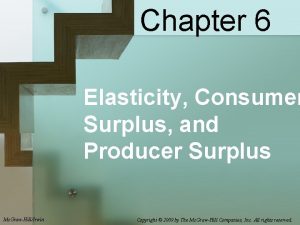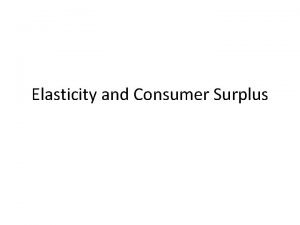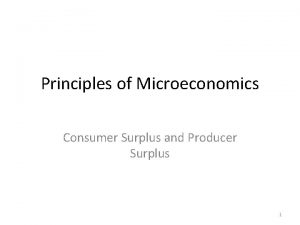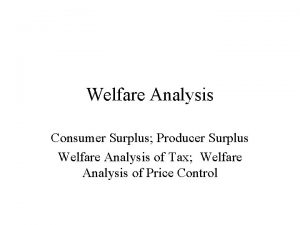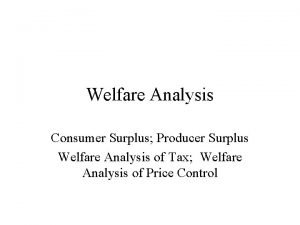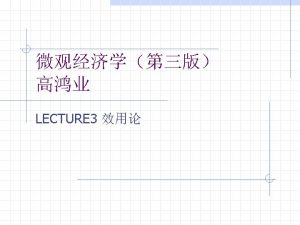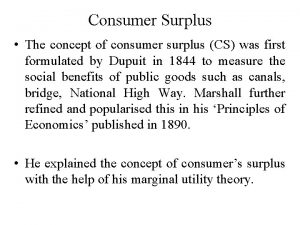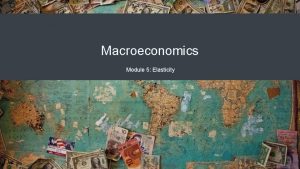Elasticity Consumer and Producer Surplus Consumer Surplus is






















- Slides: 22

Elasticity

Consumer and Producer Surplus �Consumer Surplus is the value that the consumer receives from a good above the price for that good. �Producer Surplus is the difference between the amount a seller receives for a good and the minimum amount that they would sell the good for.

Graph Surpluses �Graph the area that the consumer surplus represents and the corresponding area that the producer surplus represents based on the graph of a good at equilibrium. �Pages 116 -119 in Princeton Review Cracking the AP Economics Macro and Micro Exams.

Price Elasticity of Demand �“The responsiveness of consumers to a price change …” �For some products a minor change in price has no impact on the quantity demanded for the product- Inelastic �For other products, a minor change in the price has a significant impact on the quantity demanded for the product- Elastic �Quote is from the text Essentials of Economics.

Elasticity of Demand Formula E(d) �E(d) = % change in quantity demanded of X % change in price of X �Since we want the elasticity for price increase to be comparable to the elasticity for price decreases, we use the average of the quantities and prices for the numerator and the denominator. �The negative sign is ignored in the calculation.

Problems �Calculate the elasticity of demand for the following : � Price � $2. 00 $3. 00 $4. 00 � � Quantity Demanded 100 70 20

Calculations �Change from $2 to $3: (Change in Q/Change in P) 30/((100+70) /2)=30/85= 0. 35 � 1/((2+3)/2)=1/2. 5= 0. 4 �The elasticity is then 0. 35/0. 40 which is 0. 875. The demand is said to be inelastic.

Calculations �Change from $3 to $4: (Change in Q/Change in P) � 50/((70+20)/2)=50/45= 1. 11 � 1/((3+4)/2)= 1/3. 5= 0. 285 �The elasticity is then 1. 11 divided by. 285 which is 3. 89. The demand is said to be elastic.

Interpretation �Elastic Demand- If the % change in price is less than the % change in quantity demanded (answer is greater than 1). �Inelastic Demand- If the % change in price is greater than the % change in quantity demanded (answer is less than 1). �Unit Elasticity- If the % change in price equals the % change in quantity demanded. (answer is 1)

Perfection �Perfectly Inelastic- There is no change in demand in response to a price change (answer is 0). �Examples: Drug addictions �Perfectly Elastic- A small price reduction will cause consumers to increase their purchases to all they desire of the product (answer is infinite).

Perfectly Inelastic Demand � Price � Perfectly inelastic (E(d)=0 � Quantity

Perfectly Elastic Demand � Price � Perfectly elastic (E(d)=infinity � Quantity

Total Revenue �For a firm selling a product, their total revenue will equal the price of a unit times the number of units they can sell: � P x Q= Total Revenue

Total Revenue Problem �Based on the information we looked at previously, what is the total revenue in each of these situations? � Price � $2. 00 � $3. 00 � $4. 00 Quantity Demanded Total Revenue 100 70 20 ? ? ? Elasticity ? ? �How does total revenue change with these price changes, and how does it relate to the elasticity of the product?

Elasticity and Total Revenue �For products with an elastic demand, when the price is lowered, the quantity demanded will increase by more, and thus a firm will increase its total revenue. �For products with an inelastic demand, when the price is lowered, the quantity demanded will increase by less, and thus a firm will decrease its total revenue. �For products with an unit elastic demand, a price change will not cause a change in the total revenue.

Determinants of Elasticity of Demand �Substitutability: more substitutes, the greater the elasticity �Proportion of Income: the higher the price relative to your income, the greater the elasticity �Luxuries versus Necessities: the more a good is considered a luxury, the greater the elasticity �Time: the longer the time period, the greater the elasticity

Price Elasticity of Supply �The basic definition is similar the one for demand: � � E(s)= % change in quantity supplied of X % change in price of X �The degree of elasticity of supply depends primarily on how easy a supplier can shift its efforts to an alternate use.

Price Elasticity: Market Period �Time immediately after a price change that is too short for the producer to respond to a change in price. �Time period will differ depending on the product. �Supplier is price inelastic during this period. � � S Price D 2 � � D 1 Quantity

Price Elasticity: The Short Run �The short run is a period of time too short to change the productive capacity of the supplier (example plant capacity), but long enough to change the way the capacity is used. �Supplier is more price elastic in the short run. � � Price S D 2 � D 1 � Quantity

Price Elasticity: The Long Run �The long run is a period of time long enough for firms to change their productive capacity or for others to enter or leave the market. � � Price S D 2 D 1 Quantity

Income Elasticity �This measures the change in demand as a result in a change in income. �E(i)= % change in quantity demanded � % change in income �For normal or superior goods, the elasticity is positive as more goods are demanded as income rises. �For inferior goods, the more income a consumer gets, the less of these goods that are demanded.

Insights �Why do we care about elasticity? �What can it tell producers (suppliers)? �What can it tell us about the economy and economic changes (recession, expansion)?
 Consumer surplus and producer surplus
Consumer surplus and producer surplus Consumer and producer surplus
Consumer and producer surplus Producer and consumer surplus graph
Producer and consumer surplus graph Producer surplus definition
Producer surplus definition When are consumer and producer surplus maximized?
When are consumer and producer surplus maximized? Producers primary consumers secondary consumers
Producers primary consumers secondary consumers How to calculate consumer surplus
How to calculate consumer surplus Taxation and government intervention
Taxation and government intervention Consumer surplus integral formula
Consumer surplus integral formula Deadweight loss from tariff
Deadweight loss from tariff Define producers consumers and decomposers
Define producers consumers and decomposers Functions of ecosystem
Functions of ecosystem 1. individual demand and consumer surplus
1. individual demand and consumer surplus Is a cockroach a producer consumer or decomposer
Is a cockroach a producer consumer or decomposer Producers
Producers Is a horse a producer consumer or decomposer
Is a horse a producer consumer or decomposer Is a cockroach a producer consumer or decomposer
Is a cockroach a producer consumer or decomposer Producer-consumer problem
Producer-consumer problem Ipc problems
Ipc problems продуцент
продуцент Reader writer problem
Reader writer problem Websll
Websll Government tariffs
Government tariffs
